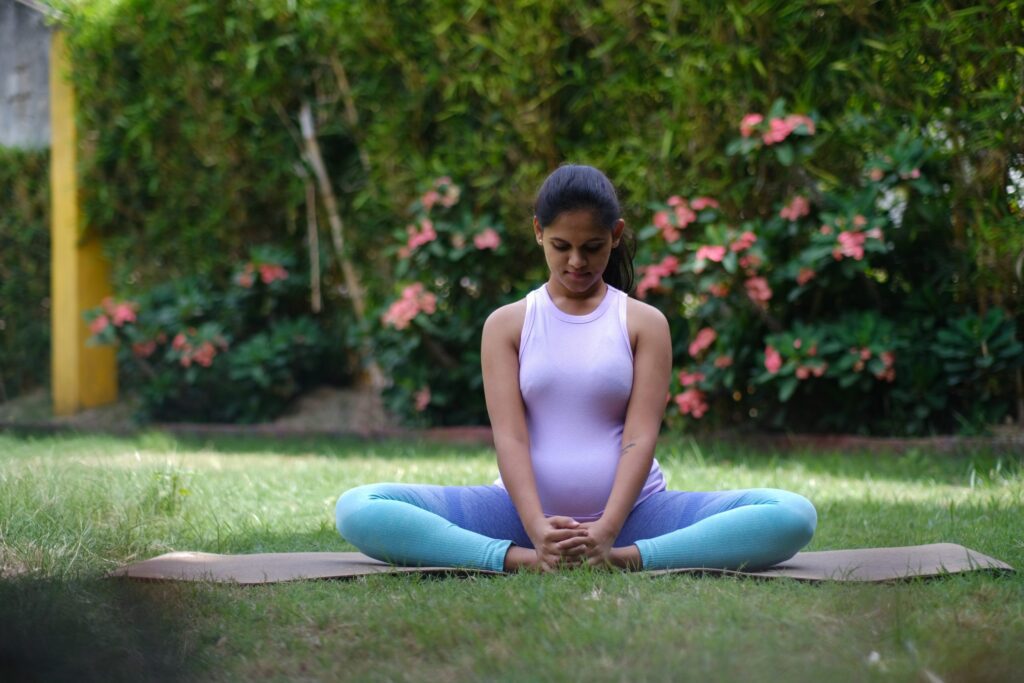Yoga for common issues during Pregnancy
Pregnancy brings in a lot of changes in a woman’s mind and body. Some of the common issues faced by them like nausea, back pain, constipation, breathlessness, and swelling of ankles and feet are a topic of concern. This article is an attempt to address these issues, their major causes, and ways to minimize or reduce their impacts.
Introduction:
Pregnancy is the time from fertilisation of the ovum to birth. The first thing the women are likely to notice is missing menstrual period followed by a few other symptoms like fatigue, nausea, tender or swollen breasts which are triggered by the hormonal changes in the body. Pregnancy is divided into three trimesters-
- The first trimester is from week 1 to 12
- The second trimester is from week 13 to 26
- The third trimester is from week 27 till the end of pregnancy
During these trimesters a woman will go through many changes physically, mentally, and emotionally, among which few will be addressed in this blog.
Importance of yoga during pregnancy
Physical Benefits:
- Increases strength, flexibility, and endurance of muscles needed for childbirth
- Helps in preventing and relieving back pain, fluid retention, leg cramps and much more
- Helps with pain management during labour

Emotional Benefits:
- Reduces stress, anxiety, and fear
- Helps to create a bond and connection with baby
- Helps to create trust and faith in one’s body
Pregnancy yoga guidelines:
Some of the generic guidelines for any woman practicing yoga during pregnancy-
- No compression, strain or overstretching of the belly
- Avoid strong twists, backbend and inversion or any intense asanas
- Do not hold postures for a long period
- Avoid lying on the back from the second trimester. Supine postures can be done with care
- Do not give intense hip opening, malasana and other hip opening postures can be done for a few breaths
- Release any posture that doesn’t feel right or creates discomfort
Common issues during pregnancy
1. Morning sickness
Nausea and vomiting are commonly referred to as morning sickness. However, the condition is not limited to mornings, it can strike at any time of the day or night. The causes of morning sickness are not known. However, the hormonal changes during pregnancy like oestrogen or low blood sugar levels are thought to play a significant role. Symptoms start from 5 to 8 weeks and usually subside by week 13 to 14.
How to ease morning sickness?
Here are some of the tricks you can try to ease morning sickness during pregnancy-
- Grated amla juice can help (maximum 1-2 amlas)
- Lemon with sugar and rock salt will ease nausea
- Opt for foods that are high in carbohydrates, low in fat, and easy to digest
- Avoid greasy, spicy and fatty food
- Consume less quantity with more frequency rather than three large meals
- Drink plenty of fluids, sip water or ginger ale
- Avoid food or smells that make women nauseate. Get plenty of fresh air and walk outside
Yoga to manage nausea:
- Baddha konasana
- Supported supta virasana
- Shashankasana
- Chair supported upavistha konasana
- Yoga Nidra
When to consult a doctor:
- Vomit that is brown or has blood
- Vomited more than 3 times a day
- Lose more than 3 Kgs
- Produce little urine
2. Back pain
There can be many possible reasons why it happens, few reasons include-
- Weight gain: During pregnancy, women typically gain between 10 to 15 Kgs. The spine has to support the weight that can cause back pain
- Posture changes: Pregnancy shifts the centre of gravity, as a result, it may put a strain on the back
- Hormonal changes: During pregnancy, a woman’s body releases a hormone called relaxin that can cause ligaments that support the spine to loosen leading to instability and pain
- Stress: Emotional stress can cause muscle tension in the back which can result in back pain or back spasm
How to ease back pain?
- Hot and cold packs can help to relieve the pain. Start with a cold pack for 20 minutes a day. After two or three days, switch to the heating pad on the painful areas
- Improve posture: Using proper posture when working, sitting, sleeping can help to reduce tension around muscle
- Avoid sleeping on the back
Yoga to reduce back pain:
- Tadasana
- Marjaryasana
- Utthita shishosana
- Vyagra Svasa
- Ashwa sanchalanasana
- Setu bandhasana
- Jatara parivartanasana
- Yoga Nidra

When to consult a doctor?
- Back pain is severe
- Rhythmic cramping pains
- Increasingly severe pain or pain that begins abruptly
3. Constipation
- Increase in pregnancy hormone progesterone can cause the gut to work less efficiently and food to move slowly through the intestines.
- Another cause for constipation can be because of the medicine that women consume during pregnancy. Supplements like iron and calcium as well as some multivitamins can trigger constipation.
- Low fibre diet can also lead to constipation
How to ease constipation?
- Increase fluid and fibre in the diet
- Consume less quantity with more frequency
- Eating wholegrain, fruits and vegetables can help
- Probiotics can help to improve bowel movements
- If constipation is severe, laxative can be taken after consulting a doctor
Yoga to relieve constipation:
- Pawanmuktasana
- Malasana
- Triyaka tadasana
- Kati chakrasana
- Vajrasana
- Ashwa sanchalasana
- Ustrasana
- Yoni mudra
4. Breathlessness
Shortness of breath in early pregnancy is caused by an increased level of progesterone. However, this might go away after a few weeks. It may recur after the second or third trimester. As the baby grows larger inside the woman’s abdomen, the other organs are squeezed and pushed aside. The lungs might not have enough room to expand and the diaphragm is compressed.
How to ease breathlessness?
- Sit or stand straight- these positions give lungs more room to expand
- Slow down movements- when movement is slow, the work of the heart and lungs is less
- Sleeping with pillows supporting the upper back can help get more oxygen
Yoga to manage breathlessness:
- Virabhadrasana A and B
- Marjaryasana
- Breathing stretches
- Ardha ustrasana
- Setu bandhasana
- Supta baddha konasana
- Supta virasana
- Pranayama like Nadi shuddhi and Brahmari
When to consult a doctor?
- Heart palpitation
- Rapid pulse
- Dizziness
- Cough that doesn’t go away
- Blueness around lips, fingers or toes
- Fever or chills
- Worsening asthma
- Chest pain
- Coughing up blood
5. Swelling of ankle and feet
Swelling is caused by a woman’s body holding more water than usual when they are pregnant. Throughout the day the extra water tends to gather in the lowest parts of the body especially if there is no movement for a long time. The pressure of the growing womb can also affect the blood flow in the legs. This can cause fluid to build up in the ankle and feet.
How to ease swelling?
- Avoid standing for a long period without moving
- Wear comfortable shoes (avoid heels, tight straps that pinch)
- Keep the feet up as much as possible
- Limit salty foods and excessive salt in the diet
- Sleeping on the left side can help blood return to the heart
- Massage will help to reduce swelling
Yoga for swelling:
- Sukhsma vyayama
- Vajrasana
- Wall supported uttanapadasana
- Adhomukha svanasana

When to consult a doctor?
- When the face or hands are swollen
- Swelling that gets dramatically worse
- Dizziness or blurred vision
- Difficulty breathing
- Severe headache
Swollen feet can sometimes be a sign of more serious problems like preeclampsia. This condition can develop during pregnancy and can cause high blood pressure. So it is important to consult a doctor when swelling becomes abnormal.
Summary:
During pregnancy, women go through many hormonal changes due to which some of the common issues like nausea, back pain, constipation, breathlessness, swelling of ankle and feet can be caused. All these issues are common during pregnancy as a woman’s body has to adapt to the growing baby. These issues can be handled with yoga, diet and lifestyle changes.
If you are a teacher planning to guide your students during pregnancy, check out our Prenatal Yoga Teacher Training Course.
This blog was originally written by Abinaya, Level 2 Indea Yoga Teacher, and edited by Team Indea Yoga. This was a part of her dissertation work during her Level 2 Teacher Training Course.


